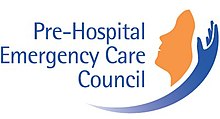Pre-Hospital Emergency Care Council
 |
|
| Formation | 2000 |
|---|---|
| Legal status | Active |
| Headquarters | Naas, County Kildare, Ireland |
|
Region served
|
Ireland |
|
Director
|
Peter Dennehy |
| Website | http://www.phecc.ie |
| Remarks | Appointment: Minister for Health |
The Pre-Hospital Emergency Care Council (PHECC) is an independent statutory organisation responsible for implementing, monitoring and further developing the standards of care provided by all statutory, private and voluntary ambulance services in Ireland. It is also responsible for conducting examinations at six levels of pre-hospital care, the control of ambulance practitioner registration and the publication of clinical practice guidelines.
There are six levels of care set down by PHECC. They are divided into Responder levels and Practitioner levels. Currently, all practitioners working on emergency ambulances must be trained to a minimum of PHECC Level 5 (Paramedic) standard. A practitioner working on a non-emergency ambulance must be trained to a minimum of PHECC Level 4 (EMT) standard. Responder levels are suitable for fire service personnel (excluding Dublin Fire Brigade), voluntary ambulance organisations, sports clubs and workplace first aiders.
Responder levels of care are designed to provide basic medical training to lay people, non-medical emergency services staff (Gardaí, fire services), sports club staff and those designated to provide first aid at work. In addition to this, voluntary ambulance services such as Civil Defence, Order of Malta Ambulance Corps, Irish Red Cross and the St John Ambulance Brigade of Ireland depend on responder training to allow their members provide on-site first aid at the various events they cover. Certain remote communities have set up their own individual Cardiac First Response programmes, where various people in the area are trained to PHECC Level 1 (CFR) standard and are provided with an Automated External Defibrillator. These responders can then be called or paged to the scene of a cardiac arrest to provide CPR and defibrillation, where the increased response time of an ambulance would greatly affect the patient's outcome.
...
Wikipedia
